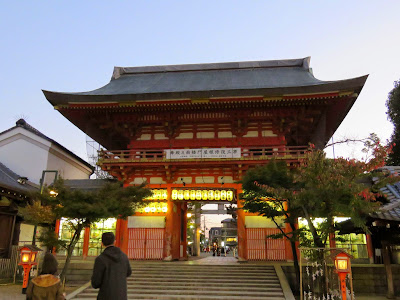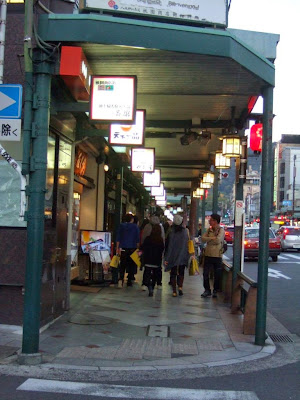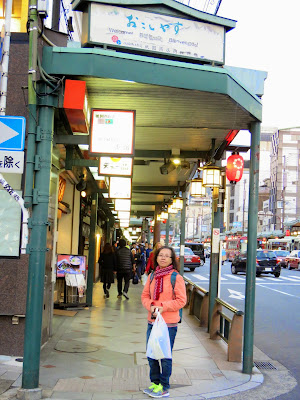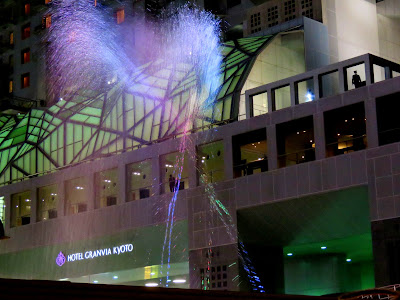
Kyoto, having a history of more than one thousand two hundred years, is a living museum of Japan's great cultural heritage. The basic grid pattern of the city remains as what it was first laid. Meandering or strolling within the city on foot to explore its old Buddhist or Shinto temples and many other architectural and historical sites, are our most wonderful experience. This is my second visit to the old capital of Japan and after a week's close contact, I still feel that I have not seen enough of it. There are still many interesting treasures and sights that due to timing, we were forced to leave behind for the next trip. Kyoto is indeed a sightseer's paradise.


Sakyo-ku district, formed in year 1929, is one of the 11 wards in Kyoto Prefecture. It lies on North East of Kyoto City with Kamo River flowing on its west border. It is the place where many notable buildings situated including universities, museums, libraries and famous Shinto Temple Heian Jingu, which is the destination of one of the three most important festivals in Kyoto. Festive of Jidai Matsuri celebrating the founding of Kyoto city is held on October 22nd, when huge procession carrying mikoshi (portable shrine) of Emperors Kammu and Komei took place with 2000 people attired in costumes from all periods in Kyoto history. The parade marches its way from the original site of imperial palace to here.


Heian was the former name of Kyoto City. The Shinto Temple named after it when it was built in year 1895 to celebrate the 1100th anniversary of the establishment of Heian-kyo, the founding of Kyoto Capital. Heian Jinja is an important cultural property of Japan and its giant sized arching Tori gate erected in year 1929 over a busy road is considered the largest in Japan. It measures 24.2 meters high with top rail of 33.9 meters and it is the mark towards the Shrine.



The Shrine ground designed with a wide open court at the center, is rather spacious. The orange, green and white colored main shrine building was a smaller scale replica of original imperial palace from Heian Period, which had been destroyed in 1227. The Shrine dedicated to the spirits of the first Emperor Kammu (737-806) who founded Kyoto in 794, and the last emperor Komei (1831-1867) who lived out his reign in Kyoto before the capital was moved to Tokyo. Heian Jinja has east and west hall (Honden) and a State Hall (Daigoku-den) where Heian Emperors issue legal orders.


The main and inner sanctuary, ritual hall, platforms and several other structures were added in year 1940 on the deification occasion of Emperor Kamei. Nine of its buildings including the main sanctuary Honden Hall were burnt down in 1976 but restored three years later with public donated funds.


The lovely lanterns hanged at the corridors bears the designs of four Chinese sacred animals that represent four elements and four directions. Green Dragon always placed at left side of any structure, representing wood element and east direction; and, White Tiger that placed on right side represent gold element and west direction;


Crimson Phoenix always in the front position of a structure, represents fire element and south direction; and Xuanwu the Black snake or tortoise that represents water and north direction is always placed at the rear portion. Earth element is in the center and yellow color always is used to apply for it.


Heian Jinja is well known for its gardens with large pond which is a rare feature of a Shinto. There are three of them, at east, west and north direction. The stone path crossing the pond was built from pillars of a 16th century bridge that spanned Kamo River, and destroyed in earthquake. The typical Shinen Garden on the left was built during Meiji era. It is famous for fall foliage, spring weeping cherry trees and summer flowers irises and water lilies. At the spacious court, there are two prosperous old lime trees and tree branches that fully tied with fortune paper slips. Locals believe that this is a way to have good fortune come true.


Nijo Castle was built in year 1603 by the first shogun of Edo period (1603-1867) Tokugawa Ieyasu as a residence for his visit to Kyoto. The castle was completed and expanded with a five storey castle keep 23 years later by his grandson Lemitsu. It was donated to the city as a historical site in 20th century. Nijo Castle survived in its original form, is one of the best example of castle palace showing the architecture of Japan feudal era. In 1994, it was listed as a world heritage site.


The ground of Nijo Castle and its Honmaru and Ninomaru palace, various buildings and gardens are protected and surrounded by walls and moats. The site is reputable for gorgeous details and a specially constructed nightingale flooring connecting corridors that were able to give sign when visitors approaching.


The famous Chinese styled Karamon Gate before Ninomaru Palace is just behind the first entrance gate. We did not manage to make it and see the first shogun's residence as it was raining and turning dark.


Nijo Castle is closed on 4.30pm every day but today it was crowded with people especially youngsters after its closing time. They came specially for the computer aquatic extravaganza theatrical production show held inside the castle.



Yasaki Shrine lies just next to the famous cherry blossom park Maruyama. It was first built in year 656 dedicating to God of prosperity and good health, Susa-no-o and his consort. Most of the present structures at site were restored in 1654. The two tiers gate Romon was constructed with striking red posts and white walls on top of a flight of steps at the end of bustling Shijo-dori area. Entrance is protected from evil spirits by two flanking guardians and stairs leading to main shrine were protected by two stone lion-dogs.


Most important building of Yasaki Shrine is the single storey wooden roofed main shrine hall, at the left side of the central area. It consists of Honden inner sanctuary and Haiden offering hall. Yasaka Shrine was once known as Gion Jinja. During early Heian era (794-1185), it was one of the first 20 shrines supported by the Government and today it remains an important shrine for the local residents. Million of people flock in to pray for good fortune and health especially in new year, when temple organizes Okera Mairi for worshipers to take home a flame from the sacred fire to cook their first meal of the year. Yasaka Shrine also is a place where new born babies are brought here for registration, and where celebration of children reaching the age of 3, 5 and 7 take place in mid November each year.


Opposite the main shrine hall at the center of the site stands a ceremonial Dancing Stage decorated with hundreds of white lanterns bearing the name of company sponsors who make contributions to the temples. Lanterns get lit up after dark. The stage currently is used for tradition marriage ceremony.


The beautiful sight of illuminated lanterns at night in Yasaka Shrine.


Yasaka Shrine is the host to the world famous summer festival Gion Matsuri in Kyoto. The celebration come with massive floats and hundreds of participants. Gion Matsuri has a history of more than 1100 years. It began in year 869 when Omikoshi (portable shrines) of Gion Jinja paraded through the streets of Kyoto to ward off an epidemic that had hit the city. Today it is one of the three largest festival in Kyoto, attracting crowds of people, local and abroad, to join in this annual grand occasion.



There are many classic restaurants near Maruyama Park and Yasaka Shrine.


The bustling Shijo-dori shopping district.










The beautiful narrow lane of Ishibei-koji is the pedestrian only lane in Kyoto and Hanami-koji-dori is the geisha district in Gion area.


The illuminated Kyoto Tower at night compared to its daytime sight is much imposing and outstanding.



The 15 storey high Kyoto Station is the major railway station and transportation hub of the city. The station incorporated with a shopping mall, hotel, movie theater, departmental stall and several government sectors, is the second largest rail station in Japan.



The station was first opened for service by decree of Meiji Emperor in February 5th 1877. It was burnt down in 1950 but replaced two years later with a more facilitated usage. The current station was opened in 1997 to commemorate the 1200th anniversary of Kyoto's founding.



Water fountain lights performance at Kyoto Railway Station.








No comments:
Post a Comment